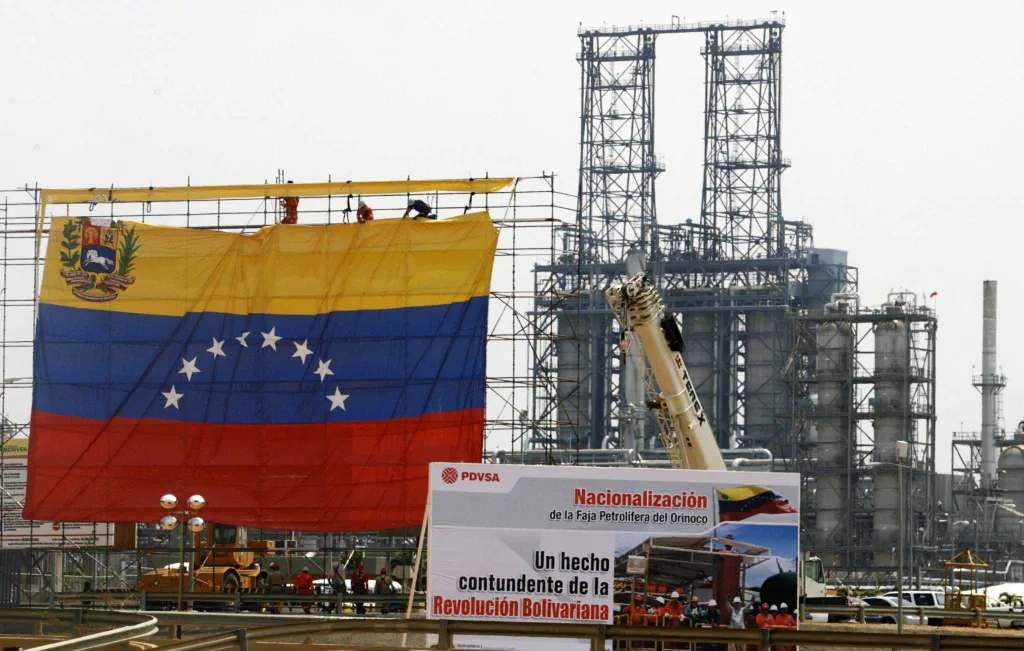
Oil workers hang a Venezuelan flag at the Jose Complex during celebrations in Barcelona, Venezuela, May 1, 2007, as the state-run oil company PDVSA takes control of oil fields in the Orinoco Belt. Photo: Jorge Silva/Reuters/file photo.

Orinoco Tribune – News and opinion pieces about Venezuela and beyond
From Venezuela and made by Venezuelan Chavistas

Oil workers hang a Venezuelan flag at the Jose Complex during celebrations in Barcelona, Venezuela, May 1, 2007, as the state-run oil company PDVSA takes control of oil fields in the Orinoco Belt. Photo: Jorge Silva/Reuters/file photo.
Caracas (OrinocoTribune.com)—Venezuelan crude oil production grew for the seventh consecutive month in September, reaching an average of 1,105,000 barrels per day (bpd) according to official figures published Monday by the Organization of the Petroleum Exporting Countries (OPEC).
This represents a 0.63% increase from August, when the country with the world’s largest proven crude reserves produced 1,098,000 bpd.
August and September 2025 were particularly unusual months for Venezuela, as the US deployed Navy warships off the coast of the country and escalated its threats and rhetoric against Venezuela to unprecedented levels.
Sustained growth amid sanctions
Nevertheless, Venezuela has reported slow but sustained growth in its oil production since last March, when it reached 1,048,000 bpd. This means production has increased by 5.43% through September, according to official figures, despite the strengthening of illegal US sanctions.
#OPEC’s Monthly Oil Market Report for October 2025 is now available online #MOMR
Download 👉https://t.co/a9NcCcq8QR pic.twitter.com/K7PweRESDk
— OPEC (@OPECSecretariat) October 13, 2025
According to secondary sources cited in all OPEC monthly reports, production increased by 27,000 bpd, reaching 967,000 bpd. A slight difference between primary and secondary sources is a common occurrence in OPEC reports, especially for countries subjected to sanctions, such as Venezuela.
Navigating diluent shortages
After the lifting of the OFAC license for Chevron early this year, Venezuela’s ability to acquire diluents for its heavy oil was greatly affected. However, specialized sources report that alliances with the Russian company Kpler have helped reduce the impact by supplying naphtha to the Venezuelan market since March.
These same sources indicate that Venezuela restocked its inventories of these diluents from US providers while the Chevron license was still valid, reporting a significant increase of 94% in March. Iran is another important supplier of diluents that Venezuela has used in the past.
Global demand growth
On Monday, OPEC maintained its forecast for global crude oil demand growth in 2025 and 2026, driven primarily by the transportation sector, at 1.25% and 1.31% year on year, respectively.
In its monthly report, the organization reiterated its relatively optimistic outlook for oil consumption based on the forecast that the global economy will grow solidly, around 3%, both this year and next.
Venezuela’s Ruling Party Rejects Chevron Dependency Claims: We Do Not Live Off Oil Giant
It estimates that the planet will burn an average of 105.14 million bpd of crude oil in all of 2025, 1.30 million bpd more than in 2024, and another 106.52 million bpd in 2026, representing a further year-over-year increase of 1.38 million bpd. All these figures are unchanged from last month’s estimates.
However, analysts at the oil group also admit that significant “uncertainties” could alter the outlook, such as “inflation levels, monetary tightening measures, and sovereign debt levels.”
Special for Orinoco Tribune by staff
OT/JRE/SL
Support Groundbreaking Anti-Imperialist Journalism: Stand with Orinoco Tribune!
For 7 years, we’ve delivered unwavering truth from the Global South frontline – no corporate filters, no hidden agenda.
Last year’s impact:
• More than 200K active users demanding bold perspectives
• 216 original pieces published in 2025 alone
Fuel our truth-telling: Every contribution strengthens independent media that actually challenges imperialism.
Be the difference: DONATE now to keep radical journalism alive!